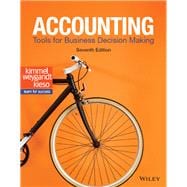Accounting: Tools for Business Decision Making, 7th Edition is a two-semester financial and managerial accounting course designed to show students the importance of accounting in their everyday lives. Emphasizing decision-making, this new edition features relevant topics such as data analytics as well as the time-tested features that have proven to be of most help to students.









